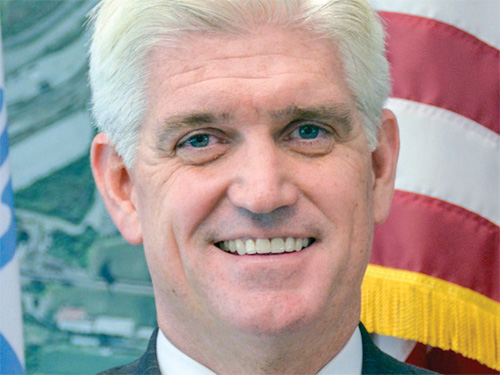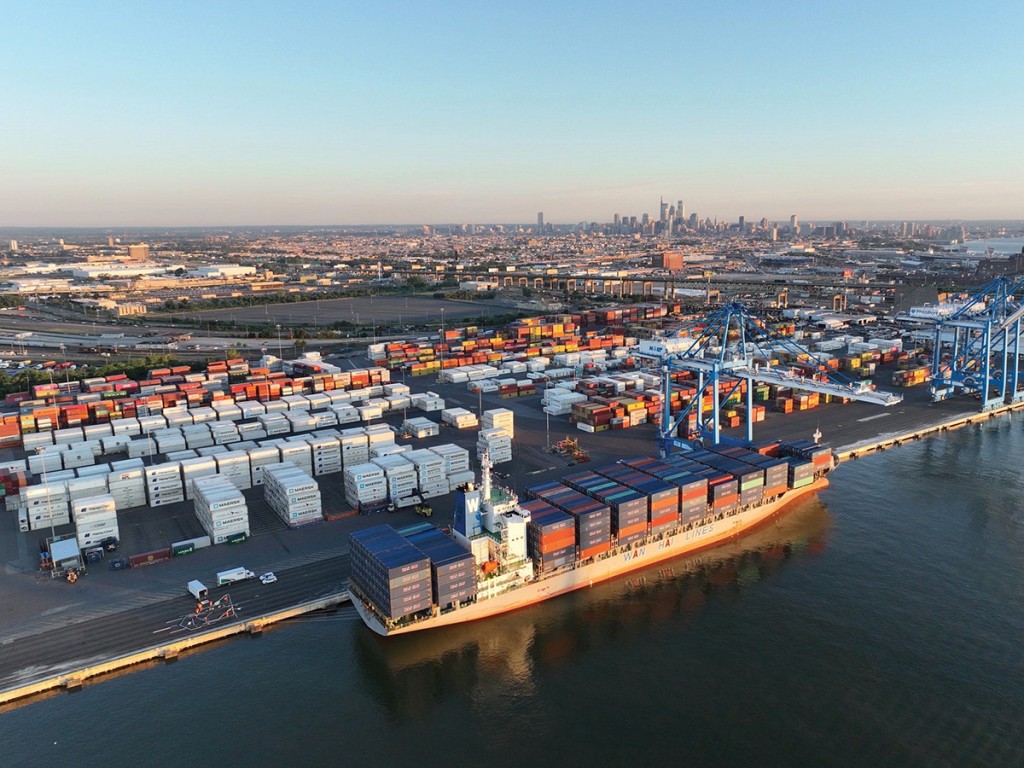Seaports in Philadelphia, southern New Jersey and Wilmington, DE, are seemingly always prospering and expanding.
Sean Mahoney, director of marketing for PhilaPort, indicates that the dozen terminals belonging to PhilaPort increased annual volumes by four percent in 2022 versus 2021. On average, U.S. East Coast ports averaged a five percent increase over 2021. But a key ingredient in those numbers is that there was no decrease in Philadelphia volume during 2020 because of the pandemic. Other East Coast ports saw as much as double-digit declines in volume in 2020, so PhilaPort’s 2022 increases are truly remarkable. PhilaPort handled 762,632 TEUs of cargo in 2022.

Wintertime fruit arrivals in Philadelphia are strong again to start 2023. The Packer Avenue Marine Terminal, which is operated by Greenwich Terminals, is increasing its capacity, due to investment from PhilaPort and Gloucester, NJ-based Holt.
Holt’s own Gloucester Fruit Terminal is also expanding and adding volume capacity for receiving.
Downstream, GT USA has exclusive rights to operate and develop the Port of Wilmington for 50 years. Owned by Gulftainer, the company is planning to invest $580 million in the port. This includes approximately $410 million for a new 1.2 million TEU container facility at DuPont’s former Edgemoor site, which was acquired by the Diamond State Port Corporation in 2016 and is immediately upstream of Port Wilmington, which was founded in 1923. Receiving heavy banana ships, Wilmington is the largest fruit port in the United States.
But the Delaware River also receives a great deal of dry cargo.
Ocean Wind a Long-term Project for SJPC
For the next 20- to 25-years the South Jersey Port Corporation expects to be occupied with providing monopile foundations for wind turbines to Ocean Wind and additional offshore wind projects. Brendan Dugan, SJPC’s assistant executive director and CCO, said Ocean Wind is in its first phase, which is to place 100 towers off the coast of Atlantic City. Phase two calls for 200 towers. The corporation is based in Camden, NJ.
The tubular monopile segments are shipped from Germany in pieces and then welded together in a circular welding building at the Paulsboro, NJ, marine terminal.
Dugan describes the finished monopile tubes as having a 30-foot diameter. Fitted together, three of these segments, which when welded together are the length of a football field, are inserted vertically into the Atlantic Ocean floor. These tall tubes are in water deep enough that they will never be in view as they support the wind turbine towers.
Furthermore, Ocean Wind has gained national notoriety because six dead whales have washed up on the New Jersey shore in recent weeks. Initially, national news broadcasts quoted sources who indicated that something about the nature of Ocean Wind was killing the whales.

But on Jan. 15, NBC News quoted Madisen Young, an administrative assistant with the Marine Mammal Stranding Center, who said one whale’s stomach was full of partially digested fish and there was fecal matter in the intestines, indicating the whale had been actively feeding prior to these injuries. NBC added, “Other dead whales have also turned up in coastal areas of New Jersey and New York. Scientists say there has been an increase in whale sightings closer to the coast over the past several years.
“Vessel strikes and entanglement in fishing gear are the largest known human threats to whales of all species,” Young said. “Although there has been speculation about whether these whale deaths are linked to wind energy development, at this point no whale mortality has been attributed to offshore wind activities. We will continue to gather data and go where the science leads us.”
On that topic, Dugan reiterated to AJOT: “Let’s see where the science leads us.”
Dugan said SJPC operates two terminals in Camden, Broadway Terminal, which mostly handles forest products and Balzano Marine Terminal, which is mostly steel. There is some overlap in cargo between the facilities. Key break bulk cargoes are steel coils, steel plates, structural and steel pipe. The wood products mostly consist of plywood from southeast Asia.
An interesting breakbulk product is West African cocoa beans which are seasonally discharged at Balzano, mostly arriving between December and April. Packed in 50 pound bags, the beans go to four warehouses with a total of 274,000 square feet. Those beans are mostly processed in Pennsylvania and southern New Jersey.
Other bulk products going to the SJPC are recycled materials for export and different types of raw materials, such as sand that is used to make concrete, and concrete per se. Gypsum, which is used to make wall board is imported.
Dugan said COVID pandemic disruptions made business difficult for his terminals because the sale of steel coils to automotive plants dropped, “which had a dampening effect on our steel coil imports.” Furthermore, demand for plywood imports declined. He explains that plywood is used for recreational vehicle construction as well as the more-predictable residential and commercial construction.
He adds, “In 2021 Camden’s imported steel business took off dramatically and was 37% higher than 2020. And 2021 hit an all-time volume high for the South Jersey Port Corporation. In 2022 our business was four percent better than 2021.”

Other Commercial Products on the Delaware
On Jan. 26, PhilaPort announced a huge milestone at Philadelphia’s SouthPort Marine Terminal: It had attained the import of two million cars arriving through Philadelphia. Involved with PhilaPort in the celebration were Glovis America, Penn Auto, the International Longshoremen’s Association (ILA) and Teamsters.
A press release indicated that since the start of operations in 2010, Glovis America has consistently grown their volumes via The Port of Philadelphia – having reached a record of 221,022 vehicles in 2022.
“It’s been a good partnership,” said Jeff Theobald, PhilaPort executive director, and CEO. “We started with 88 acres and one VPC (vehicle processing center) and now we have two VPCs on 265 acres.” Berth construction began in late 2022.
In 2019, PhilaPort completed the SouthPort Marine Terminal, which it tabs the most advanced auto processing facility on the Eastern seaboard.
A New Tioga Terminal Warehouse
The Biden Administration awarded PhilaPort $20.3 million to construct a new 100,000 square-foot warehouse at the Tioga Marine Terminal, as well as safety and efficiency upgrades with the modernization of the terminal’s main gate.
This is part of the U.S. Department of Transportation 2022 Infrastructure for Rebuilding America (INFRA) grant program, which will help the port meet a growing demand and attract more business.
“The Port of Philadelphia is a critical link in our nation’s supply chains. By increasing capacity at the port, we’re allowing more commerce to flow through Philadelphia, getting goods to families more efficiently and supporting local jobs,” said U.S. Senator Bob Casey. “This is another example of how the Biden Administration is delivering on its promise to invest in our infrastructure and strengthen our economy.”
The project was developed in a collaborative planning effort between the facility’s terminal operator, Delaware River Stevedores and PhilaPort.
“With this grant PhilaPort is able to meet the demands of the current market and add much needed capacity in the warehouse space,” said Jeff Theobald, PhilaPort executive director and CEO. “We receive calls daily from shippers looking for dry storage. With the construction of a new 100,000 square-foot warehouse, we will have the ability to attract new business, that will result in the creation of additional family sustaining jobs for the region.”
Construction of this project is slated to begin in 2024.
Upon completion of the new warehouse, Tioga Marine Terminal, which has recently seen an increase in demand for pulp, project cargoes, steel, and lumber products, will have over 800,000 square feet of on-dock warehousing.
The safety improvements for the entrance to the terminal, including completion of a modernized gate, will increase terminal efficiency while reducing emissions and increasing safety for both port and non-port related entities.
“Safety of our labor force is paramount. With a modernized gate and approach to the terminal we can ensure that both the port and public are protected as the port continues to grow,” said Jerry Sweeney, chairman of PhilaPort’s board of directors.

Additional benefits of this project include new cargo capture; improved truck circulation and terminal efficiencies as well as improved connections to the regional, multimodal network; safety and security improvements; and environmental benefits resulting from reduced truck queuing/idling and conversion of cargo from truck to rail.
The new on-dock warehouse and gate modernization is just the latest chapter in the port’s growth.
Since 2016, Pennsylvania has invested more than $539 million in the port’s infrastructure, warehousing, and equipment. Critical infrastructure investments included the purchase and implementation of three new super post-Panamax cranes at the Packer Avenue Marine terminal, the building of two new state-of-the-art warehouses, and the development of the Southport Auto Terminal, the first new port terminal in more than 45 years. Since implementing the infrastructure improvement plan, the port has realized record breaking cargo volumes, nearly 60% container growth, and created thousands of new jobs.





